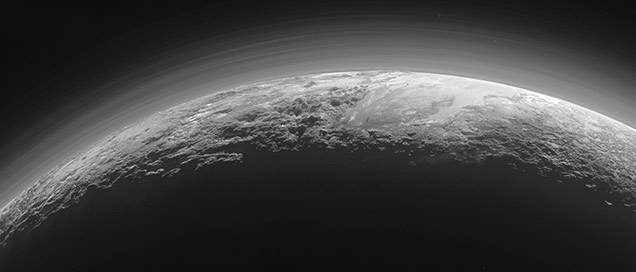The astronomical phenomenon that is space is slowly becoming less mysterious
 CREDIT: NASA
CREDIT: NASAThe most recent set of data sent by New Horizons to reach Earth gave researchers and enthusiasts a stunning time-lapse of the spectacular flyby, as well as images of the surface of Pluto backlit by the Sun shining through the dwarf planet's hazy atmosphere.
September is busy for everyone with new classes, new friends and new experiences. But the world of science doesn’t stop for your schedule, especially the work of astronomers and physicists studying outer space. So for all of you who have been too busy to keep up, here’s a quick rundown of what’s happened during September in science.
Terraforming Mars
Elon Musk, the 44-year-old founder of SpaceX, Tesla and other start-ups, made headlines again this past week when he stated his idea to terraform Mars with nukes. Terraforming is the process where humans change an environment to better suit their living needs. It is something mostly discussed in science fiction, but was brought up while Musk appeared on The Late Show with Stephen Colbert in early September stating, “The fastest way [to terraform Mars] is drop thermonuclear weapons over the Poles”.
Before this part of the discussion occurred, Colbert had asked Musk his intentions for the world, saying he needed to choose between being a superhero or super villain.
Musk responded with a cool “I try to do important things”, but between this and wanting a million people in his Martian City by 2100, it’s safe to say Colbert is probably right in saying “You’re a super villain, that’s what a super villain does”.
Since the interview aired, Musk tweeted, “Btw, not saying we *should* nuke Mars -- just layin’ out a few options …”. Various scientists have also publicly stated that directing asteroids at the carbondioxide- and-water-ice-rich Polar Regions to release the greenhouse gasses, in order to jumpstart the process is a more feasible answer to terraforming the planet.
NASA’s New Horizons
NASA’s New Horizons probe is now hurtling towards its next planned object in the Kuiper’s Belt. Though, over the next 16 months, the probe will continue to send back gigabytes of data ranging from temperature and atmospheric information, to photos and a chemical analysis of Pluto.
The next object for the New Horizons probe to study is 2014 MU69, a 30 to 45-kilometre long rock body, set to reach it by January 2019.
This body was chosen after researchers gave several proposals for continued operation of the probe past its original mission, having officially reached Pluto on July 14, 2015. Its Pluto explorations made it the first ever human-made craft to explore this planet.
Mars’ South Pole
It seems we just can’t get enough of the Red Planet. The European space Agency (ESA)’s 10-year-old Mars Express Orbit recently photographed Mars’ South Pole in pristine detail. The detailed shot shows the Southern Poles ice cap standing out against the dusty red colour of the iron-rust environment.
Scientist theorize these water deposits will make it easier for humans to one day setup research and living colonies on the planet, giving future scientists and colonists more space for bringing necessary equipment with them for their new pioneer lifestyle.
Another interesting fact about water is that it is currently the base components for rocket fuel, making trips home less costly. One thing’s for sure, Mars has water waiting, an estimated one million-plus cubic kilometers of the liquid gold just sitting nicely packaged for us.
When the ESA’s Philae comet lander reached Comet 67P/Churyumov– Gerasimenko on Nov. 12, 2014 the ESA achieved something never tried before: landing a human construction on a comet hurtling through space.
Despite its success, there were still things that went wrong, including Philae’s failure to attach itself with harpoon-like tools and ice grips to the surface of 67P. Instead it went on bouncing into space for an agonizing two hours, finally landing on the edge of a crevasse, but unable to function for more than 60 hours due to the lack of available sunlight.
Two groups of scientists working with NASA have recently unveiled new robot prototypes which would solve the aforementioned problem by allowing the rover to move anywhere without the help of external pieces.
In early September researchers showed off “Hedgehog”, a pair of space probes that each use three internal flywheels and braking systems allowing them to roll, hop, bounce or shoot themselves straight into the air in a tornado-style manoeuvre, all from a sitting position.
Hedgehog, which looks strangely like the companion cube from popular videogame franchise Portal, is currently in its second phase of development, which means more news will follow.














